What if your farm produces half the crop using urea with minimum effort and profit as well?
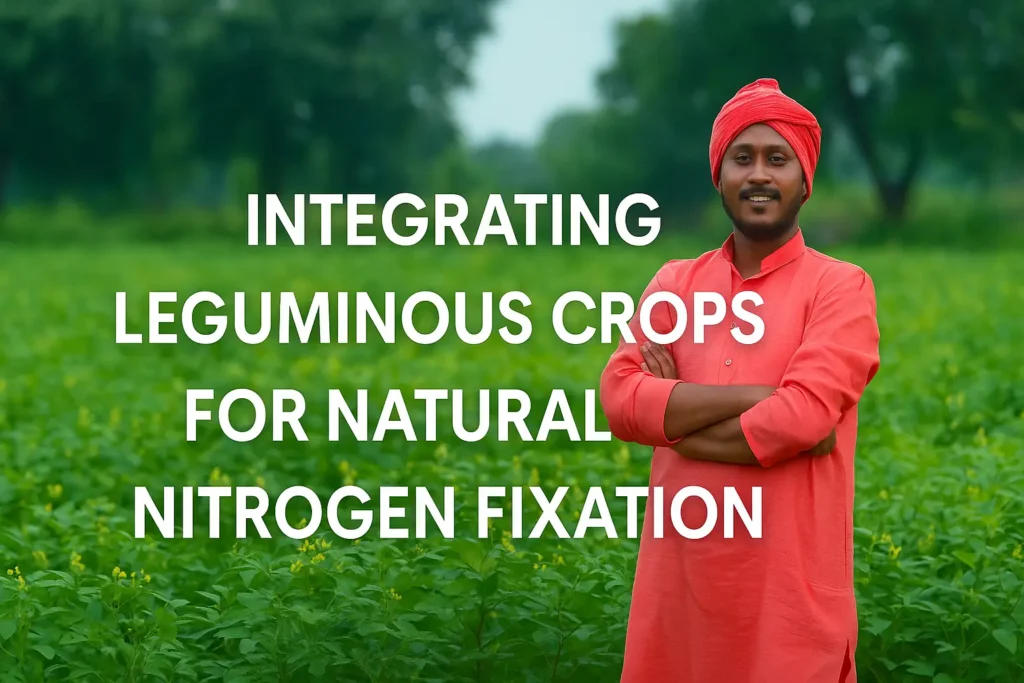
Ramesh, a smallholder farmer from Madhya Pradesh, once told me, “Every year, I spend more on urea, but my yields don’t improve much. My soil feels tired.”
Another farmer, Ram Singh, from Bihar, reduced his fertilizer costs by 40% just by planting moong dal(pulse) between his main crops (like Maize).
Curious how? Because Ram Singh used a centuries-old, science-backed trick that modern agriculture is rediscovering that is, especially the role of Leguminous Crops in Nitrogen Fixation used as intercrop. These help both risk management and improve soil health.
What Are Leguminous Crops and Why Are They Special?
These Pulse crops belong to the Fabaceae family. Examples are moong, urad, lentils, peas, beans, chickpea, soybeans,groundnut etc. They are rich in proteins, yes—but even more importantly, they fix atmospheric nitrogen into the soil.
Concept:
Legumes (like moong, urad, arhar(pigeon pea), chana, and soybeans) have a superpower – they form a partnership (symbiotic relationship) with Rhizobium bacteria in their roots.
These bacteria live in nodules in the plant’s roots take nitrogen gas from the air and convert it into a form plants can use. It’s like installing a free nitrogen generator in your field. This process is called biological nitrogen fixation.
How do leguminous plants increase soil fertility?
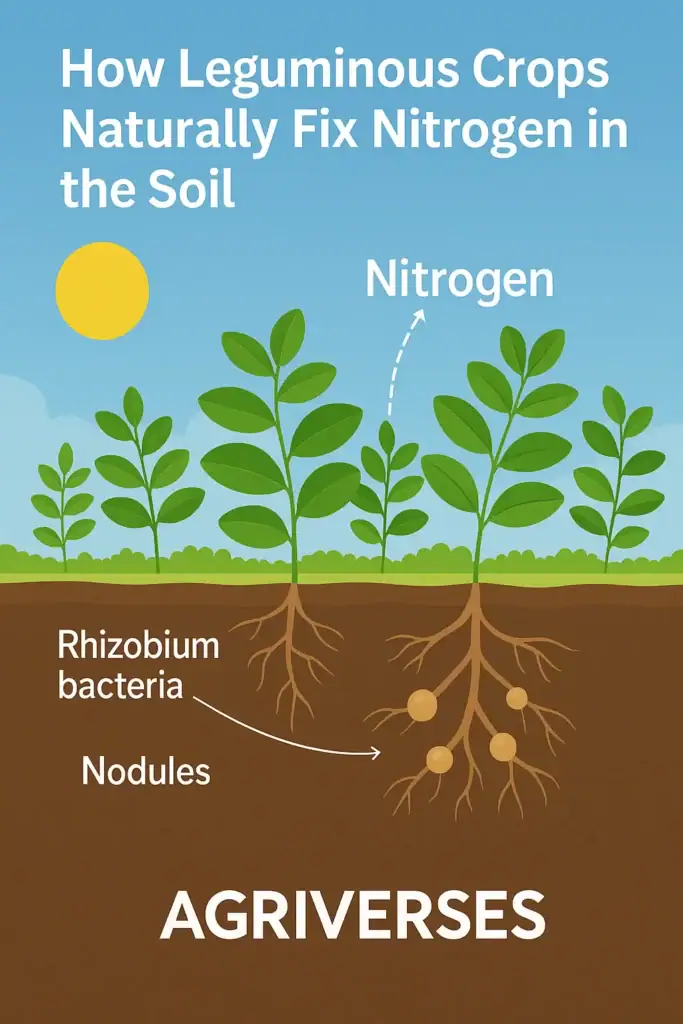
Maintaining the health of the soil is important for every farmer. In this, leguminous plants act as a natural doctor. But how?
Now we will know how nitrogen fixation actually works. Suppose you have planted moong dal, the roots inside the soil contain Rhizobium bacteria. what these bacteria do, is convert the nitrogen present in the soil into ammonia (NH₃) form which is easily used by the plant for its growth.
In return, the plant gives food in the form of sugar to the bacteria to live in the root nodules and to eat and also become healthy for human consumption.
When the crop cycle of legume plants is complete or their roots remain in the soil, that nitrogen is released into the soil. This provides good nutrition to the next crops – like wheat, rice – without chemical fertilizers.
In simple language, these two things help each other is called symbiotic relationship.
And the best part? The benefits extend to the next crop in your rotation, like wheat or maize. That’s nature’s way of saying, “I’ve got your back.”
List of common Nitrogen-fixing crops in India
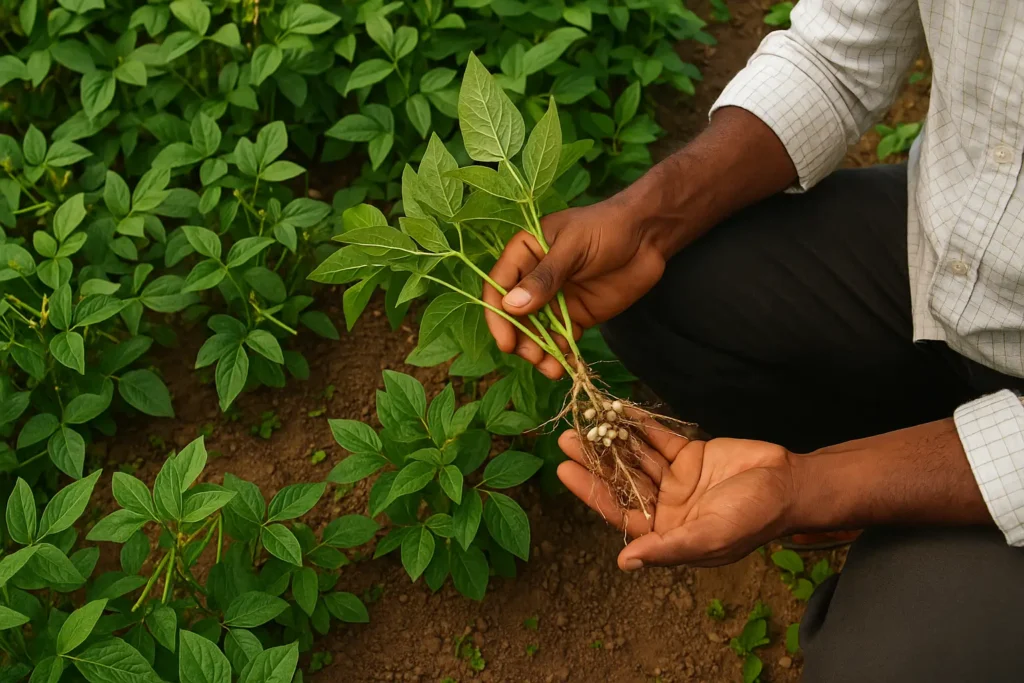
Nitrogen-fixing crops are quite popular in India – especially in agricultural areas where people practice organic or low-input farming. Here is a list of some important leguminous crops that Indian farmers regularly grow:
- Moong (Green Gram) – Popular in Kharif season and short duration crop.
- Urad (Black Gram) – Suitable for humid climate, this is strong nitrogen fixer.
- Masoor (Lentil) – Rabi crop, increases nitrogen in the soil and is also protein-rich.
- Arhar/Tur (Pigeon Pea) – Has deep root system, drought-tolerant and help loosens the soil.
- Chana (Gram) – Grown during winter in Central and North India.
- Soybean – Top-class for nitrogen fixation, on a large-scale in Madhya Pradesh and Maharashtra.
- Lobia (Cowpea) – Multi-purpose: vegetables, pulse, and green manure.
Including these crops in crop rotation not only increases soil fertility but also reduces dependency on chemical fertilizers. And yes, bees and pollinators are also attracted – meaning the whole farm becomes an eco-system.
Integrating Leguminous Crops in Your Farming System
There are three main ways to integrate legumes into your system:

1. Crop Rotation – Giving the Soil a Breather
Instead of growing wheat or rice season after season, try crop rotation specially follow local pattern, with pulses like moong or lentils. This simple switch breaks pest cycles or attack and quietly loads the soil with nitrogen.
Example: Crop Cycle
Wheat (Rabi) → Moong (Zaid) → Paddy (Kharif)
In my village in Azamgarh, an old farmer I know switched from wheat-rice to this rotation — and the soil became visibly healthier. Fewer pests’ attacks, better yields, and lower urea use.
2. Intercropping – Let Crops Support Each Other
This one’s smart. Plant a legume alongside your main crop. It is like teamwork in the field.
Try this combo:
- Maize + Cowpea
- Sugarcane + Soybean
A farmer in Punjab once showed me his maize-cowpea field. The cowpea covered the ground like a green carpet, saving moisture and fixing nitrogen naturally. Less weed, better land use — it just made sense.
3. Green Manuring – Feeding the Soil, Not Just the Crop
If you have got fallow land or a gap between seasons, grow a fast legume like dhaincha or sunhemp — and plough it back in. It’s free organic fertilizer.
Last summer, I visited a farmer who planted dhaincha on a small patch. The smell of fresh greenery, the way the soil looked after ploughing it in — it reminded me that sometimes, the best inputs don’t come in a bag.
Data-Driven Analysis:
According to ICAR, leguminous crops can fix 50 to 200 kg of nitrogen per hectare per season, depending on the species and soil conditions.
- FAO recommends legumes as an integral part of sustainable intensification.
- NABARD reports show that intercropping legumes has improved productivity and reduced input costs in tribal farming systems.
- Recent research from IARI (2023) found that farmers rotating legumes with cereals saw a 15-30% yield increase in the subsequent crop.
Table: Common Leguminous Crops and Their Nitrogen Fixation Potential
| Crop | Season | Nitrogen Fixed (kg/ha) | Bonus Benefits |
|---|---|---|---|
| Moong | Zaid | 30–40 | Short duration, high value |
| Urad | Kharif | 20–30 | Pest-resistant, hardy |
| Cowpea | Kharif | 40–50 | Fodder + food |
| Soybean | Kharif | 50–60 | High protein, cash crop |
| Dhaincha | Summer | 80–100 | Excellent green manure |
| Sunhemp | Kharif | 70–90 | Fast growing, pest repellent |
Farmers’ Real Problems with Legumes (and What Actually Works)
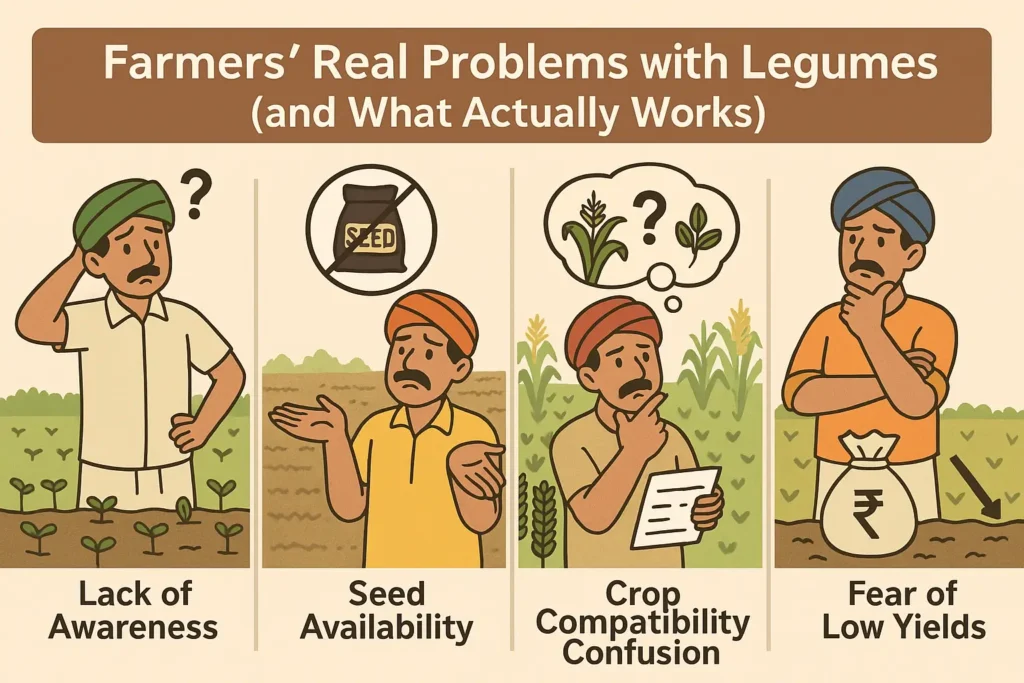
Let’s face it — legumes(include beans, peas, and other Protein-rich crops) are underrated. Most farmers do not see moong or arhar as anything more than “dal (as a pulse crop).” But these humble crops? They are quietly doing miracles underground. Nitrogen-fixing, Soil-reviving and Cost-cutting.
Still, adoption is low, why?
Because it is not that simple, Lets explain!
1. Lack of Awareness – “People just don’t know the full benefits!”
Farmers are not avoiding legumes because they are lazy or unaware — they just have not seen the value with their own eyes. You cannot expect someone to grow moong between their maize unless they’ve seen it actually work in a real field, not just in a government pamphlet.
What helps?
Live demos. A neighbour’s field showing results. KVK teams coming to the village and not just talking theory but putting hands in soil.
Once they see, they believe.
2. Seed Availability – “We want to grow it, but where’s the seed?”
You know what is frustrating? Wanting to try something new and not finding the basic tools. Certified seeds of moong or urad are not always available in local markets. And when farmers use random seeds from last year, germination becomes a gamble.
So, what works?
Seed banks. Trusted ones, preferably run by the community. Even better if they’re backed by agri universities or FPOs. Some states have started mobile seed vans — that is smart thinking.
Even a WhatsApp group for seed exchange in a village could do wonders.
3. Crop Compatibility Confusion – “Which legume suits which crop?”
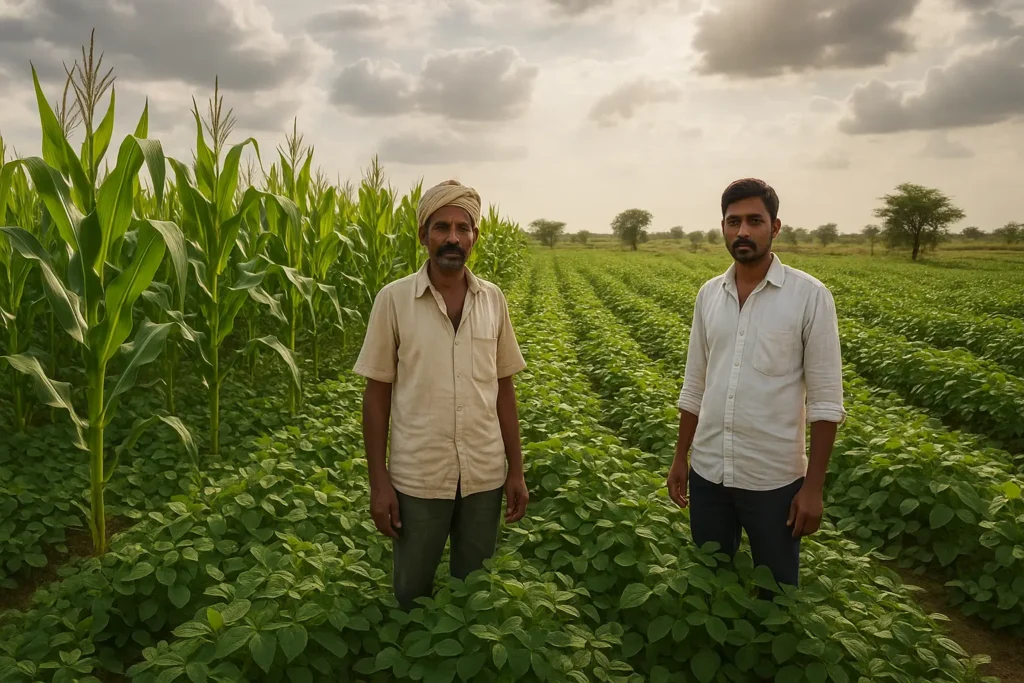
Here is the thing: intercropping is not plug-and-play. Farmers often ask — can I sow moong with sugarcane? Will arhar reduce my bajra yield?
And they are right to ask. Crop pairing matters.
The fix?
Visual pairing guides. Posters with pictures — not jargon. Or short reels in local language showing someone sowing maize with moong. If a small farmer in Nalanda can do it, others will follow.
It is not about science-heavy documents — it’s about real-life matches.
If you have doubt about any farming related problem, you can follow agriculture related blog like agriverses. You can ask question directly through comment box.
4. Fear of Low Yields – “Why grow it if I can’t sell it for profit?”
This is the hardest mindset to shift.
Many farmers think, “Why should I waste time growing something that will not sell big in the mandi(market) ?” And they are not wrong — legume yield might be lower, price not always great.
But here is what they miss: it is not about that harvest.
It is about the wheat crop after that is Less urea,Better soil, Higher yield and Lower input cost. That’s where the real profit hides.
Explain it like this:
“Moong is not your main earner; it is your soil’s nutrition plan. You grow it now, so your next crop grows even better.”
Once that clicks, you have won.
Role of Leguminous Crops in Nitrogen Fixation
You know, not all crops just take from the soil—some actually give back. These beans, peas family crops are one of those rare types. I remember seeing my uncle in Azamgarh growing moong every year, not just for harvesting dal, but because “soil becomes strong,” as he said. Back then, I did not get it, Now I do.
These crops team up with little bacteria called Rhizobium, which live in their roots. Together, they sort of pull nitrogen straight from the air—like grabbing fertilizer from the sky—and fix it into the soil. No factory-made urea needed.
And here is the real deal: if you grow legumes before wheat or rice, chances are you’ll need less fertilizer next season. It’s a smart, old-school trick—cheap and effective.
This is not just a theory. It is happening in fields every day. And our older generation knew it way before us, even without lab reports. They just trusted the land.
So yeah, Nitrogen-fixing crops are not just food—they’re soil healers. Kind of underrated heroes, if you ask me.
Final Takeaway: Grow Smarter, Not Harder

Legumes may look humble, but they quietly do what expensive fertilizers cannot—they heal your soil, fix nitrogen, and cut down your costs. In today’s farming, where every input drains the pocket, crops like moong or arhar(pigeon pea) are silent game-changers.
You do not need a big farm or big investment. Just one smart step—add a legume to your next crop plan. Maybe between maize, or with bajra. Your soil gets stronger, and your next harvest gets better.
👉 Talk to your local KVK or an experienced farmer in your village. Trust nature’s shortcut to sustainability.
And next time someone says farming is too costly, smile and say—
“Mere moong se milta hai free ka nitrogen, bhai!”
👇 Comment if you are trying this—and do share it with your farming friends. And also read my journey to become an agriculture blogger.
FAQs – Farmers Often Ask About Legumes & Nitrogen Fixation
What leguminous plants help in nitrogen fixation?
Protein-rich crops like moong, urad, arhar, lentils, and cowpea naturally fix nitrogen in the soil with the help of Rhizobium bacteria in their root nodules. These crops reduce the need for chemical fertilizers and improve soil health.
How does the nitrogen-fixing process work in legumes?
Legumes form a partnership with nitrogen-fixing bacteria like Rhizobium. These bacteria live in small nodules on the plant roots and convert atmospheric nitrogen into a usable form for plants—this process is called biological nitrogen fixation.
Can legumes grow in poor or low-fertility soils?
Yes, legumes like sunhemp and cowpea are stress-tolerant and can grow in low-nutrient or even slightly saline soils. They not only survive but also improve soil fertility for future crops.
Do I still need to apply urea after growing legumes?
In most cases, nitrogen requirements drop after a legume crop. However, high-demand crops like wheat or paddy may still need a reduced dose. A simple soil test can guide you better.
Where can I get a list of nitrogen-fixing plants or Rhizobium culture?
You can get updated legume crop lists and Rhizobium cultures from Krishi Vigyan Kendras (KVKs), ICAR research centers, or agri input stores. Some PDF guides are also available on ICAR and NABARD websites.
Can Pulse crops replace urea completely?
Not always. While Pulse crops reduce urea dependency significantly, complete replacement may not be practical in high-yield systems unless combined with compost or green manure.




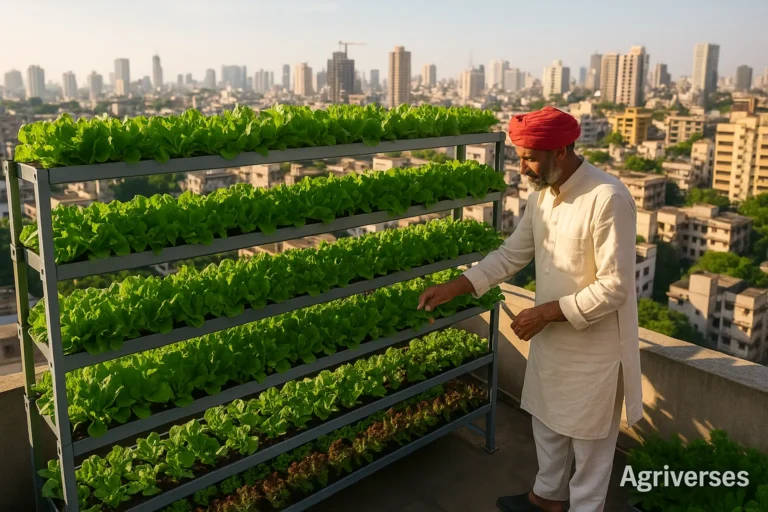


3 Comments